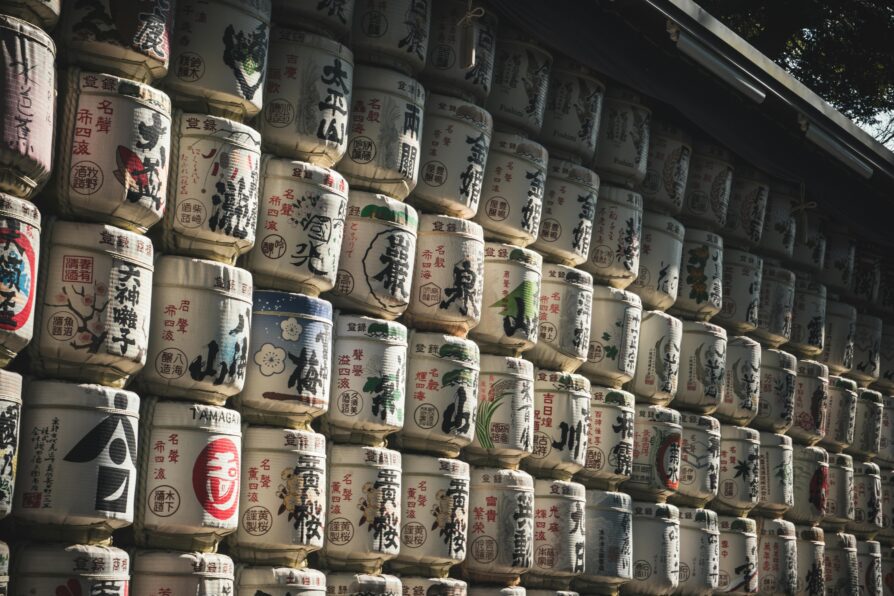Sake Cocktails

Sake Cocktails
Water and yeast are the same for both beverages, but the grain necessary for fermentation differs – barley for beer and rice for sake. Koji, a mold that aids in the fermentation process, is another distinguishing ingredient in sake. It converts rice starches into sugars to facilitate the production of alcohol. 
Sake is traditionally enjoyed by itself in small, specialty sake cups which are sometimes slightly larger than a shot glass — but don’t mistake that for thinking it should be shot. On the contrary, sake is meant to be sipped, much like tea or wine.
Sake can also be served either hot or cold. Hot — or “warm,” depending on how you define the two — is a bit more common, especially for cheaper sake which is generally served warm to mask some of the less desirable qualities. Generally, premium sake is best served chilled to highlight its delicate flavors, however, sake can be served at many temperatures depending on the type of sake and preference of the drinker.
Sake tends to have some level of floral aroma and slight sweetness, but just like beer, wine, and whiskey, there is a wide range of distinct flavor profiles to explore. Some sake are dryer, while some are sweeter, fruity or even stark. We encourage those who are curious to explore the different types of sake to uncover the qualities they enjoy most.
These different characteristics and flavors make sake a great choice for cocktails. Here are three cocktails we like that showcase a fun way to explore sake and experiment with different homemade variations and types of sake, each with their own unique qualities.
Asian Pear Cocktail
Serves four
Courtesy of NHK’s Marc Matsumoto at Food Network, this cocktail blends traditional Japanese flavors to make a drink that’s refreshing but subtly autumnal. (Matsumoto also mentions that shochu can be used as an alternative to sake, too.)
It consists of:
- Peeled and chopped Asian pears: 2
- Sake: 1 cup
- Lemon juice: 1 tablespoon
- Shiso leaves to muddle or garnish, per taste: 1 for each glass
The basics for this cocktail are super easy: Simply blend the three main ingredients until smooth.
For the smoothest possible result, Matsumoto suggests straining the blended puree through a fine strainer or cheesecloth. He recommends muddling the shiso leaf in the bottom of each glass with some ice to extract flavor and aroma, then pouring in the strained puree. Voila!
The pears and lightly sweet floral notes of the sake makes this sweet-but-not-too-sweet. A pinch of lemon juice adds a subtle tartness you won’t taste directly, but helps balance the sweetness and leaves you with a refreshing, balanced cocktail. It’s perfect for early fall in the PNW (or anywhere, to be honest).
Grapefruit Sake Cocktail
Serves two
This drink comes from Chihyu over at I Heart Umami and includes a few more ingredients than the pear cocktail but doesn’t require you to get out the blender.
It includes:

- Sake: 3 oz
- Gin: 2.5 oz
- Grapefruit juice: 3 oz
- Splash of grapefruit sparkling water
- Grated ginger root: 1/8th teaspoon
- Pinch of nutmeg
To garnish:
- Rosemary
- Grapefruit slices
Once you have all the ingredients, this cocktail is just as simple to put together as the Asian pear cocktail if not easier. Add the sake, gin, grapefruit juice ginger, nutmeg, and ice into a shaker and shake vigorously — a good rule of thumb for any shaken cocktail is to not skimp on the shaking! Then strain the mixture into serving glasses. Top with the splash of grapefruit sparkling water — Chihyu uses Perrier — and you’re all set!
Between the gin, sake, grapefruit, and ginger, this cocktail offers a bittersweet, aromatic freshness. It’s extremely refreshing and ideal for spring and summer, while the nutmeg adds a touch of warmth.
Pineapple Jalapeno Sake Sangria
Serves eight
The last cocktail is a sweet, refreshing, slightly spicy sangria made with sake instead of wine courtesy of Helene Henderson at Food And Wine. It’s both the easiest and the most complicated of the three.
It consists of:
- Pineapple juice: 4 ½ cups
- Dry filtered sake: 750 ml
And a homemade jalapeno simple syrup of:
- Water: ¾ cup
- Sugar: ¾ cup
- Jalapeno: 1, sliced thin
If you make your own cocktails regularly, you know that while you can buy simple syrup at the store for much more than it costs to make, it’s incredibly easy to whip up yourself in just a minute. The formula is simple: equal parts water and sugar, simmered briefly until the sugar dissolves.
You can create flavored simple syrups by adding other ingredients during the process — in this case, jalapeno slices. The result is a syrup that’s sweet and spicy, giving this sangria an extra kick to complement the sweet-tangy pineapple and floral notes of the sake.
For this sangria, you’ll want to make the jalapeno simple syrup ahead of time so it has enough time to cool. This extra step is what makes this a bit more “complicated” than the other two recipes.
If you want to make more or less of this sangria, remember that the ratio of simple syrup to pineapple juice is one to five. The ratio of pineapple juice to sake is a bit trickier at about 1.4 to one. Luckily this is all a matter of taste; you can adjust these ratios as you see fit.
Once the syrup has cooled, combine it with the pineapple juice and sake in a large pitcher. Give it a stir, and your sake punch is ready to serve. This delicious, summer-y drink is perfect for your seasonal get-togethers under the sun.
The diversity of different sake flavor profiles means there are endless possibilities for creative cocktail concoctions. We always recommend getting to know different sakes on their own first to understand their unique qualities. From there, use your creativity to see what cocktails you can bring to life!




